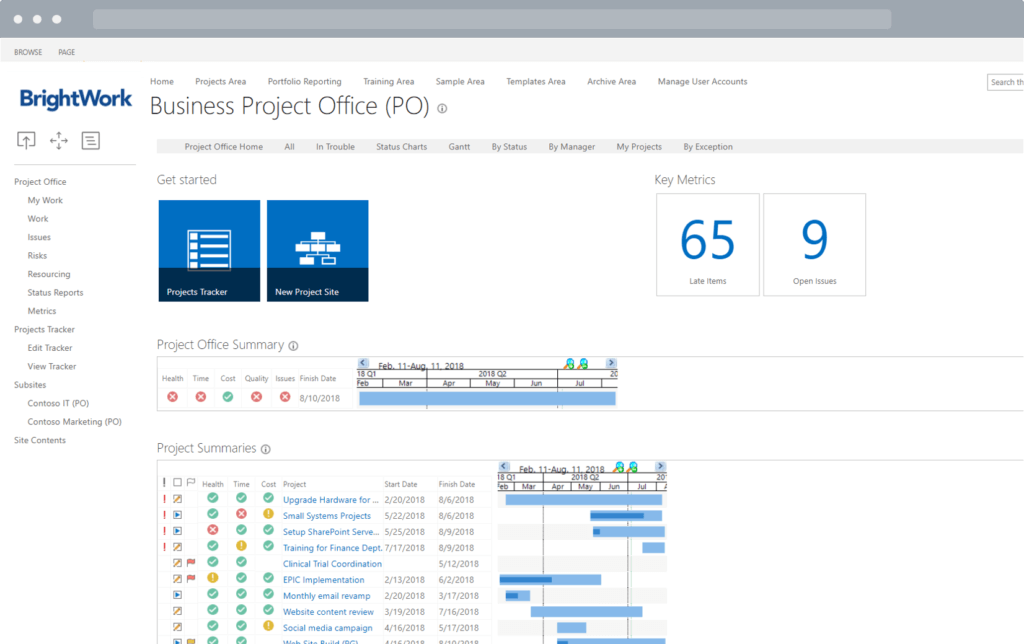Lean Management is a set of tools that help to improve productivity, reduce costs, and improve quality. When applied to project management, Lean practices lead to more project completed on time and within budget with a greater focus on efficiencies and business value.
Watch the BrightWork video tour to see our project and portfolio management software for SharePoint 2019/2016/2013/2010 in action
The goal of the Lean Project Management Office is the creation of a continuous stream of projects to deliver customer value with minimum waste of resources within the fastest time possible.
8 Best Practices for A Lean Project Management Office
1. Simple Processes
- The key to a successful PMO is to keep the processes simple, fit for purpose, clearly explained and understood, and aligned with the needs of the stakeholders.
- Focus on delivering business value, not developing complex processes.
- Each project should be viewed as an individual process with inputs and outputs. The project portfolio is the management of these individual project processes.
2. Identify Stakeholders
- A PMO needs to identify the relevant stakeholders, and determine their part in the project lifecycle process, their responsibilities, their requirements, and achieve alignment on metrics to measure the PMO performance against their measures of customer satisfaction.
3. Project Charter / Mandate
- A fundamental critical success factor for a Lean Management PMO is every project should have a project charter or mandate.
- A project charter ensures initial alignment between all the stakeholders.
- There should be a clear statement communicated to stakeholders and adhered to – No Project Charter or Mandate, No Project!
4. Portfolio, Pipeline, and Resource Management
- The goal of portfolio and pipeline management is to manage the number of projects in the pipeline and their release to avoid overloading resources.
- An aim of Lean for pipeline management is to focus resources on the highest priority projects to finish sooner and avoid starting new projects until resources are available. Multitasking is not viewed as an efficient way of working; it’s better to level the workload.
- Use Portfolio and Resource Management best practice to prioritize projects based on business value.
- A visible portfolio management process will facilitate the prioritization (and reprioritization) of new projects with organizational strategic goals.
- A benefit of an effective portfolio management process is to align resources against projects and assess project interdependencies.
- A project and portfolio management solution like BrightWork makes it easy to share information, manage resources, prioritize the pipeline, and report across the portfolio.

Example of the project management office reporting dashboard in SharePoint
5. Organizational and Process Constraints
- A focus of lean project management is to identify and manage the organizational and process constraints within a project lifecycle and ensure a continuous flow of work to ensure that no part of the system is overloaded
- An analogy to be promoted within an organization is that the project management lifecycle should be treated as a relay race (focus on dependencies and hand-offs) and then staff will see why it is important not to project overload the key constraints within a project lifecycle.
6. Project Portfolio and Projects as a Whole Picture
- See the project portfolio and the individual projects as a whole picture. Focus on hand-offs and dependencies of the project lifecycle including people, processes, services, products, and relationships.
7. Visual Management
- Use visual management and project management reporting tools such as Kanban boards to get visibility into the project portfolio and individual projects.
- Organize daily and weekly huddle board meetings with key stakeholders to review performance, status, and to identify problems to be solved.
- A best practice of lean management is for the people who do the work to do the planning.
- This is why the visual management huddle board is effective with key stakeholders so they are part of the planning and can work with those who do the planning.
- A result of this process is improved visible responsibility and accountability.
8. Continuous Improvement
- Look for small, visible quick wins in continuous improvement and ensure all stakeholders are engaged and are part of the success.
- As part of the continuous improvement process, look for wasteful practices to remove and constraints to improve in the project lifecycle.
- Each project process should be viewed as a value stream and a cookie-cutter approach may not be applicable to all project types (waterfall vs. agile).

